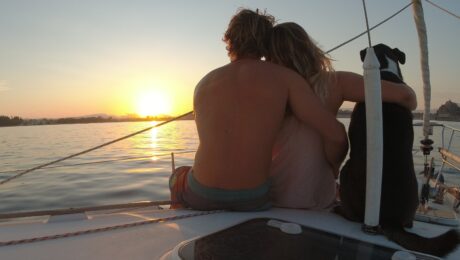To anyone who doesn’t already know, we have an amazing and unique 5-year-old dog named Kiddo. She’s been with us since she was two months old and ever since she was little she’s been with us in the ocean - surfing and sailing. As I mentioned in the previous post, when we packed up our lives and moved to live on a yacht, we couldn’t take her with us at first.
Kiddo joined us about a month after we left. I went back to Israel to bring her with me. In case anyone was wondering, at no point was there ever an option of leaving her behind since she is a huge part of our family. So, after this brief introduction, let me tell Kiddo’s story.
While still in Israel and as a part of the preparation for our new life, we wondered whether or not we should bring Kiddo with us on this journey. Mostly we questioned how she would adapt to this unusual life.
What if she gets seasick? How would we potty-train her on the boat? Mostly we were scared that bringing her along would be selfish of us, because of course we wanted to have her with us, but what good does it do if she’ll only suffer? Eventually, we decided to take the risk and try it out, with a backup plan of bringing her back to Israel if worse comes to worst.
Some beauracratic information
- In order to fly a dog abroad (I know for a fact this is true for European countries because that’s what was relevant for us) it needs to be tested for rabies antidotes. The main issue is you have to wait three months from the day of the test until your dog is allowed to leave the country. It is simply a matter of bureaucracy, and though I’ll never fully understand the three months ordeal, that’s just how it is. We had Kiddo tested in April, and I went back in July to take her. When I got to Israel I had to take her to her vet, who filled out all sorts of forms. These forms had to be filled out during a ten-day period before her flight. Another crucial matter is making sure the name on the chip your dog has is the same as the one you have on your passport. With these forms, I had to go to the regional vet, who also had to sign them.
- An important tip - don’t wait until the last minute with these forms. The regional vet works twice a week, and sometimes he’ll send you back to your vet because he didn’t fill out the forms correctly. I recommend getting it over with as soon as possible to leave little room for unnecessary issues.
- Almost done with the bureaucracy. Now onto the hardest part - what do you do on the plane? Generally speaking, a dog that weighs more than 8kg needs to go in the belly of the plane in a special travel crate, and a dog that weighs less than 8kg can board the plane with its owner. Despite Kiddo weighing 22kg, we managed to get a special authorization, and she came on the plane with me.
Done with bureaucracy - what now?
Kiddo arrived on the yacht and luckily for us, she adapted in a heartbeat (did I mention - amazing and special dog?). Being used to water from a young age, these new surroundings didn’t phase her. Before we left Israel we would take her on daily sails with us sometimes, which really helped us in this case.
On certain days, when the waves are a bit higher, she doesn’t feel as comfy onboard, but then again neither do we. She never complains, and never throws up either, so we’re assuming it’s bearable for her. The one thing Kiddo refused to learn was to defecate on the boat.
Basically, as long as we were sailing the Mediterranean Sea and had a pretty relaxed schedule, we would arrive every evening at an isolated port, dock there, and take Kiddo on the dingy and then onto the shore for a walk. We bought her a piece of synthetic grass and at first, we would take it to shore with us, and try to teach Kiddo to pee on it. After some time, we decided it’s been long enough, and Kiddo was well adapted, and we needed to properly potty-train her on the boat.
It did not go smoothly. Once again, we started digging for information on the topic, and after a lot of research, asking around on forums, consulting trainers, and watching youtube videos, we had a plan: We decided we wouldn’t take her for walks until she simply couldn’t hold it anymore, and had to go on the boat.
Breaking old habits for a grown dog, especially one as stubborn as Kiddo, is no easy task. Other dogs who got trained this way held it for 48 hours at the most until finally they broke and peed on deck. Kiddo went 60 hours without peeing or pooping, and even then she only gave in when we left the boat. When we came back and saw she had peed we were thrilled. We gave her treats and had a whole party. After that we took her on a long walk, hoping this way the amount of time she has to hold it would get shorter.
Kiddo, however, had a different idea. The next day, when she realized we were planning on leaving her on the boat and not taking her for a walk until she breaks and pees on the deck, she simply went into the yacht, curled up in the corner, and refused to talk to us. Just like that. We tried to make peace and soften her with treats, but nothing worked. It was like she said, “you took it too far and now I’m mad at you”. At this point, we decided this is one fight we can’t win. This is where she draws the line and we need to learn to work with that.
Ever since then, we take her out for walks twice a day, and on days where we sail longer, she holds it until she gets her walk. I guess you can say it’s like a peace treaty. She really is a spectacular dog, so good and incredible, she deserves this.
Kiddo arrived on the yacht and luckily for us she adapted in a heartbeat. Being used to water from a young age, this new surrounding didn’t phase her.


